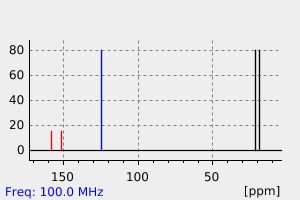2,4,6-Trimethylpyridiniumkation | 17523-60-3
中文名称
——
中文别名
——
英文名称
2,4,6-Trimethylpyridiniumkation
英文别名
2,4,6-trimethylpyridinium ion;2,4,6-trimethylpyridinium;2.4.6-(CH3)3C5H2NH(1+);2,4,6-collidinium;2,4,6-trimethyl-pyridinium cation;2,4,6-Trimethyl-pyridinium;2,4,6-Trimethylpyridin-1-ium
CAS
17523-60-3
化学式
C8H12N
mdl
——
分子量
122.19
InChiKey
BWZVCCNYKMEVEX-UHFFFAOYSA-O
BEILSTEIN
——
EINECS
——
-
物化性质
-
计算性质
-
ADMET
-
安全信息
-
SDS
-
制备方法与用途
-
上下游信息
-
文献信息
-
表征谱图
-
同类化合物
-
相关功能分类
-
相关结构分类
计算性质
-
辛醇/水分配系数(LogP):2.2
-
重原子数:9
-
可旋转键数:0
-
环数:1.0
-
sp3杂化的碳原子比例:0.38
-
拓扑面积:14.1
-
氢给体数:1
-
氢受体数:0
反应信息
-
作为反应物:描述:参考文献:名称:气相中吡啶碱之间的质子转移速率。空间和同位素效应摘要:已经通过脉冲离子回旋共振光谱研究了气相中各种吡啶碱之间的质子和氘核转移速率。结果表明,随着反应物在 2 位和 6 位被越来越多地取代,反应效率降低。一些效率最低的反应显示出小的正常动力学氘同位素效应。这些结果是根据一般机制解释的,其中包括质子转移的内在障碍。反应效率和同位素效应使用 RRKM 理论建模,并获得了固有势垒高度的估计值。DOI:10.1021/ja00529a007
-
作为产物:描述:参考文献:名称:气相中吡啶碱之间的质子转移速率。空间和同位素效应摘要:已经通过脉冲离子回旋共振光谱研究了气相中各种吡啶碱之间的质子和氘核转移速率。结果表明,随着反应物在 2 位和 6 位被越来越多地取代,反应效率降低。一些效率最低的反应显示出小的正常动力学氘同位素效应。这些结果是根据一般机制解释的,其中包括质子转移的内在障碍。反应效率和同位素效应使用 RRKM 理论建模,并获得了固有势垒高度的估计值。DOI:10.1021/ja00529a007
文献信息
-
Bromo‐ and Polybromoantimonates(V): Structural and Theoretical Studies of Hybrid Halogen‐Rich Halometalate Frameworks作者:Sergey A. Adonin、Mikhail A. Bondarenko、Pavel A. Abramov、Alexander S. Novikov、Pavel E. Plyusnin、Maxim N. Sokolov、Vladimir P. FedinDOI:10.1002/chem.201801338日期:2018.7.17Cation‐dependent reactions “[SbBr6]3−+Br2+HBr+CationBrx” result in the formation of bromide/polybromide complexes with zero‐, one‐, two‐, or three‐dimensional supramolecular frameworks and different Br/Sb ratios (up to 11). Seven new compounds representing six structural types were characterized by XRD and thermogravimetric analysis and DFT calculations enabled estimation of the energies of the Br⋅⋅⋅Br
-
Hapiot, Philippe; Moiroux, Jacques; Savéant, Jean-Michel, Journal of the American Chemical Society, 1990, vol. 112, # 4, p. 1337 - 1343作者:Hapiot, Philippe、Moiroux, Jacques、Savéant, Jean-MichelDOI:——日期:——
-
Amine Boranes. III. Propanolysis of Pyridine Boranes作者:G. E. Ryschkewitsch、E. R. BirnbaumDOI:10.1021/ic50026a029日期:1965.4
-
Steric and Kinetic Isotope Effects in the Deprotonation of Cation Radicals of NADH Synthetic Analogs作者:Agnes Anne、Sylvie Fraoua、Philippe Hapiot、Jacques Moiroux、Jean-Michel SaveantDOI:10.1021/ja00133a014日期:1995.7The deprotonation rate constants and kinetic isotope effects of the cation radicals have been determined by combined use of direct electrochemical techniques at micro- and ultramicroelectrodes, redox catalysis, and laser flash photolysis, over a extended series of opposing bases. Significant steric hindrance to deprotonation results from encumbering of the opposing base and of the functional carbon in the cation radical by alkyl groups. Kinetic isotope effects, ranging from 2 to 12 in terms of k(H)/k(D), appear upon substituting H to D at the functional carbon of the cation radical. The modest magnitude of the kinetic isotope effects and the fact that they are insensitive to steric hindrance show that proton (or H-atom) tunneling does not interfere significantly in the deprotonation reaction. All the cation radicals in the methylacridan series are strong acids, with pK(a)'s ranging from 0.8 to 1.7, as determined from thermodynamic cycles involving measured standard potentials and hydride-transfer equilibrium constants.
-
Gmelin Handbuch der Anorganischen Chemie, Gmelin Handbook: B: B-Verb.14, 3.11.2, page 124 - 131作者:DOI:——日期:——
表征谱图
-
氢谱1HNMR
-
质谱MS
-
碳谱13CNMR
-
红外IR
-
拉曼Raman
-
峰位数据
-
峰位匹配
-
表征信息
同类化合物
(S)-氨氯地平-d4
(R,S)-可替宁N-氧化物-甲基-d3
(R)-(+)-2,2'',6,6''-四甲氧基-4,4''-双(二苯基膦基)-3,3''-联吡啶(1,5-环辛二烯)铑(I)四氟硼酸盐
(R)-N'-亚硝基尼古丁
(R)-DRF053二盐酸盐
(5E)-5-[(2,5-二甲基-1-吡啶-3-基-吡咯-3-基)亚甲基]-2-亚磺酰基-1,3-噻唑烷-4-酮
(5-溴-3-吡啶基)[4-(1-吡咯烷基)-1-哌啶基]甲酮
(5-氨基-6-氰基-7-甲基[1,2]噻唑并[4,5-b]吡啶-3-甲酰胺)
(2S,2'S)-(-)-[N,N'-双(2-吡啶基甲基]-2,2'-联吡咯烷双(乙腈)铁(II)六氟锑酸盐
(2S)-2-[[[9-丙-2-基-6-[(4-吡啶-2-基苯基)甲基氨基]嘌呤-2-基]氨基]丁-1-醇
(2R,2''R)-(+)-[N,N''-双(2-吡啶基甲基)]-2,2''-联吡咯烷四盐酸盐
(1'R,2'S)-尼古丁1,1'-Di-N-氧化物
黄色素-37
麦斯明-D4
麦司明
麝香吡啶
鲁非罗尼
鲁卡他胺
高氯酸N-甲基甲基吡啶正离子
高氯酸,吡啶
高奎宁酸
马来酸溴苯那敏
马来酸氯苯那敏-D6
马来酸左氨氯地平
顺式-双(异硫氰基)(2,2'-联吡啶基-4,4'-二羧基)(4,4'-二-壬基-2'-联吡啶基)钌(II)
顺式-二氯二(4-氯吡啶)铂
顺式-二(2,2'-联吡啶)二氯铬氯化物
顺式-1-(4-甲氧基苄基)-3-羟基-5-(3-吡啶)-2-吡咯烷酮
顺-双(2,2-二吡啶)二氯化钌(II) 水合物
顺-双(2,2'-二吡啶基)二氯化钌(II)二水合物
顺-二氯二(吡啶)铂(II)
顺-二(2,2'-联吡啶)二氯化钌(II)二水合物
韦德伊斯试剂
非那吡啶
非洛地平杂质C
非洛地平
非戈替尼
非布索坦杂质66
非尼拉朵
非尼拉敏
雷索替丁
阿雷地平
阿瑞洛莫
阿扎那韦中间体
阿培利司N-6
阿伐曲波帕杂质40
间硝苯地平
间-硝苯地平
镉,二碘四(4-甲基吡啶)-
锌,二溴二[4-吡啶羧硫代酸(2-吡啶基亚甲基)酰肼]-







